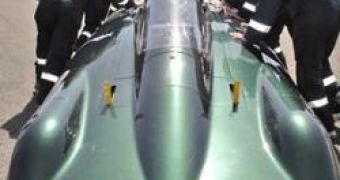No, it's not a Steam locomotive! It is in fact the latest built steam powered car dubbed 'Inspiration', which will attempt this year to break the world land speed record for steam powered land vehicles, a record that has been standing up for more than one century and which was set on Daytona Beach in 1906 by the Stanley Rocket Racer with a run averaging 205.5 kilometers per hour. Perhaps the funniest thing of all is that the following year the land speed record (at that time) was broken by a petrol powered motorcycle that reached an average velocity of 219,3 kilometers per hour.
The first world record attempt is scheduled to take place in August on the Bonneville Salt Flats, although most of the systems of the car still require thorough testing before a possible run.
'Inspiration' is a 7.6 meter long vehicle that began its life as a design exercise for a couple of postgraduate students from the University of Southampton more than a decade ago, and eventually grew into a more complex project that is now trying to set a new world record. Unlike most of its long gone cousins, the steam powered locomotives that ran on coal, 'Inspiration' uses liquid petroleum gas to heat up water and turn it into steam.
The 12 suitcase-sized boilers of the car will have the role of heating up 40 liters of distilled water to 400 degrees Celsius, creating a vapor exerting a pressure of 40 bars. The steam is then directed into a two-stage steam turbine with a top rotation peaking a 13,000 rpm, which in turn will drive the wheels of the steam powered car.
If all goes well, during the attempt in August the car should only require 10 kilometers to set a new record, at which point it may reach an average speed of 274 kilometers per hour. Until then, however, much work remains to be done, since the car even failed to start during the media presentation as a critical air valve suffered a malfunction.
"Perhaps it's a folly and eccentric, but to get this eclectic mix to work together will be a real challenge," said Matt Candy, the chief engineer of the project.

 14 DAY TRIAL //
14 DAY TRIAL //